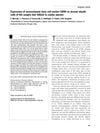Use of Human Induced Pluripotent Stem Cell-Derived CD271+CD90+ Mesenchymal Stem Cells for the Generation of Hair Inductive Dermal Cells
September 2016
in “
Journal of dermatological science
”
human induced pluripotent stem cells hiPSCs mesenchymal stem cells MSCs CD271+CD90+ dermal papilla cells DP cells hair follicle bioengineering hair follicle HF MSC markers DP marker genes growth factors minoxidil human keratinocytes fibroblasts hair follicle-like structures SCID mice drug discovery hair diseases regeneration of human HFs stem cells hair loss Rogaine keratinocytes
TLDR Human induced pluripotent stem cells can be used to create cells that help grow hair.
The study explored the potential of using human induced pluripotent stem cells (hiPSCs) to generate mesenchymal stem cells (MSCs) enriched for the CD271+CD90+ subpopulation, which are crucial for dermal papilla (DP) cell regeneration in hair follicle (HF) bioengineering. The researchers successfully cultured hiPSCs in MSC medium, resulting in cells that expressed MSC markers and could differentiate into various cell types. Notably, 10-25% of these hiPSC-MSCs were CD271+CD90+, a significantly higher rate compared to bone marrow-derived MSCs. These cells intrinsically expressed DP marker genes and, when treated with specific growth factors, exhibited DP cell-like morphology and maintained or up-regulated DP biomarkers. The induced cells responded to minoxidil and, when combined with human keratinocytes and fibroblasts, formed hair follicle-like structures in SCID mice. This study highlighted the potential of hiPSCs in generating DP equivalents, which could aid in drug discovery for hair diseases and the regeneration of human HFs.
